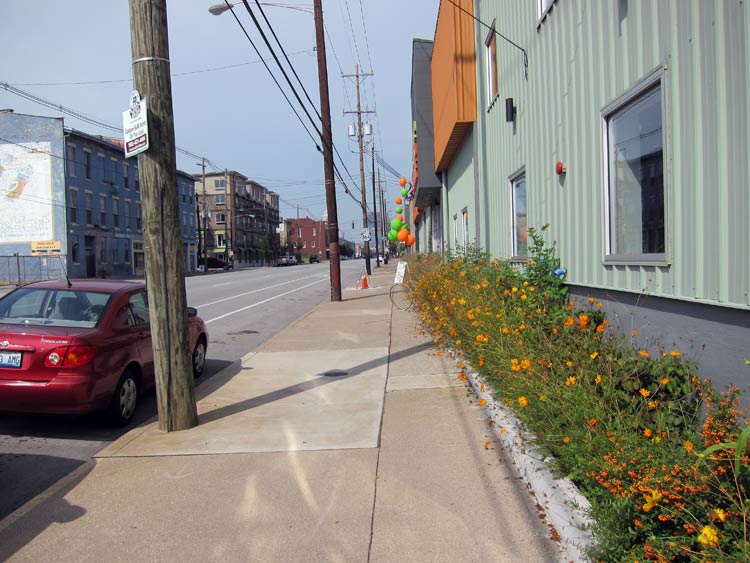
Well done, KBragg, for correctly identifying our last sidewalk photo as Floyd Street looking north between Breckinridge and College Streets in the Smoketown/Jackson neighborhood. Identify today’s sidewalk in the comments.
Local News
- LG&E is on notice: Air Pollution Control District uncovers violations. (LEO Weekly)
- Temporary ice rink planned for downtown Jeffersonville. (N&T)
- But Louisville’s downtown ice rink on hold for another year. (WFPL)
- TARC’s Barry Barker wins Humanitarian Leadership in Transportation Award. (TRB)
Kentucky
- Proposed land-use changes put Woodford County’s future at risk. (Tom Eblen)
- A Kentucky city (Owensboro) reinvents a faded downtown. (NY Times)
- Lexington moving to convert downtown to two-way traffic. (H-L)
Transportation
- The pedestrian loses the way. (NY Times)
- No more pavements: Turning roads into one giant shared space. (Guardian)
- Local economic implications of urban bicycle networks. (This Big City)
- Chicago mayor mandates public transit for city employees. (NBC Chi)
- Questioning the Car: A walk with Mark Gorton. (Omnibus)
- Sao Paulo’s “Big Worm,” an elevated highway, must go, urban planners say. (WaPo)
- Cash-strapped Wyoming DOT to halt highway expansion. Will others follow? (StreetsBlog)
- Why cities should dismantle urban highways. (Smart Planet)
- Hidden toll of traffic jams: brain cell damage & autism risk. (WSJ)
- U.S. neighborhoods struggle with health threats from traffic pollution. (SciAm)
- The folly of city-owned parking garages. (Atlantic Cities)
- Narrow roads often work better than wide ones. (New Urban Network)
National News
- Jerold S. Kayden: Occupying Wall Street at the public-private frontier. (ArchPaper)
- Redeveloping former industrial sites doesn’t mean giving up on industry. (Atlantic Cities)
- Transforming historic urban space into a vibrant cultural district. (This Big City)
- New Austin blueprint envisions new direction for growth. (Statesman)
- Study: Sprawl’s architectural similarity helps mobile Americans stay stable. (WaPo)
- Innovation lessons, imported from Detroit. (Inc.)
- Harvesting the positive potential of Detroit. (PPS)
- The eight craziest-looking food trucks (Zagat)
- Retrofitting gas stations for good. (Pattern Cities)
- Is it time to bring back the rooming house? (Citiwire)
- Rethinking ways to divide living spaces for creatives. (NY Times)



Main Street, looking west, between Wenzel and Campbell.
Too easy, but only because I happen to have band practice there on a weekly basis – Main Street between Wentzel and Campbell, looking west, and right in front of CitySpace on Main.
The link that goes with “Study: Sprawl’s architectural similarity helps mobile Americans stay stable” is the wrong link. Could you post the actual link to the Washington Post article on this topic? I couldn’t find it on the Washington Post’s website. Thanks
Thanks, Andrea. I corrected the link above. Here it is again for good measure: http://www.washingtonpost.com/realestate/commercial-architectures-similarity-across-nation-provides-mobile-americans-with-a-sense-of-stability-study-says/2011/09/07/gIQAcLFkqK_story.html
Main street west, across the street from lincoln elementary
In the photo above, the blue building on the left hand side has always seemed like a natural choice for conversion to housing, anyone know, aside from issues related to banks/lending, why this hasn’t happened? If anyone has been in it or knows about it, is it structurally sound? Free of mold?
Thanks for the informative article. Unogeeks is the top Oracle Integration Cloud Training Institute, which provides the best Oracle Integration Cloud (OIC) Training